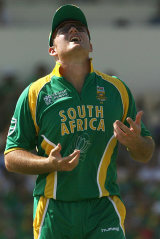 The 2007 Cricket World Cup was a dismal affair for English and South African cricket fans alike. The hosts would also not be proud of their efforts, while Australia has marched on from strength to strength, not even missing Brett Lee and saying a mighty farewell to Glen McGrath.
The 2007 Cricket World Cup was a dismal affair for English and South African cricket fans alike. The hosts would also not be proud of their efforts, while Australia has marched on from strength to strength, not even missing Brett Lee and saying a mighty farewell to Glen McGrath.
As a die hard Protea’s supporter, I struggled to find anything good in the tournament. Yet, two things stood out for me in the end.
The first is that you can’t take a First World pricing and security policy and mindlessly impose it in a Third World country. The sight of empty stadiums and the deafening silence from the crowds where horrific, and only too late did the organisers change the rules to allow musical instruments in and generate a Carribean feel. They must have lost a lot of money as local cricket fans chose to stay away rather than pay the stupidly high ticket prices for entry. Given that the tournament was also too long, so that only the very rich and bored could have stayed for the whole thing, this is nothing less than a tragedy for the proud West Indies cricket fan tradition. I wonder if South Africa’s Football World Cup organisers were watching and learning?
The second thing I noticed was the vast improvement in fielding from all teams. From minnows, Ireland and Bangladesh, to the long-time legends of South Africa and Australia, the fielding was a joy to behold. But New Zealand raised the bar yet again. Their innovative “tag team” approach on the boundaries cut off singles that last year would have been taken. Simple and elegant, the system requires one player to slide into the stopping of the ball, and then flick it up to another player who has stopped running and is already steady on his feet. He grabs the flicked up ball and hurls it back to the wicketkeeper, saving that split second which would put doubt in the batsman’s mind about taking another run.
In an interview with Jonty Rhodes, South Africa’s fielding coach, he explained another innovation that some SA fielders had been experimenting with. In order to make sure that close catching fielders were able to move in any direction as the ball flew to them from the bat, Gibbs and de Villiers and Prince are jumping up into the air – only slightly off the ground – just as the bowler releases the ball. This means that as the bowl reaches the batsman’s bat, they are landing on the ground and their muscles tensing. They are on the balls of their feet, and actually, since they had been walking in prior to jumping, they are also slightly off balance.
It is by being off balance that they are able to then move in any direction, left or right, forward or back, very easily as the ball comes flying to them from the bat. The more important it is for them to be able to make quick movements in unpredictable directions, the more important it is for them to deliberately put themselves in an out of balance position. They need to be constantly moving, and always bouncing.
It strikes me that in a business world where your competitors are constantly raising the bar, and where last year’s “good enough” really looks a bit amateurish this year, that we need to create the ability for nimble change and constant adjustment to market conditions and competition. To do so, we could apply the techniques Jonty Rhodes has perfected, and ensure that we keep our organisations and teams slightly “off balance”.
It is easier to move something that is already moving, than to overcome the inertia of a stationary object. In the same way, if people in our companies get used to the fact that we are always “on the balls of our feet” with daily small changes and adjustments, then when the big changes are required, they’re “change ready”. I’d call this “creative chaos”, and I’d suggest that its essential in most industries today.
OK, now back to drowning my sorrows, and plotting the demise of Ricky Ponting and his mates…
Dr Graeme Codrington is a business strategy consultant and futurist with TomorrowToday.biz, and can be contacted at [email protected].


